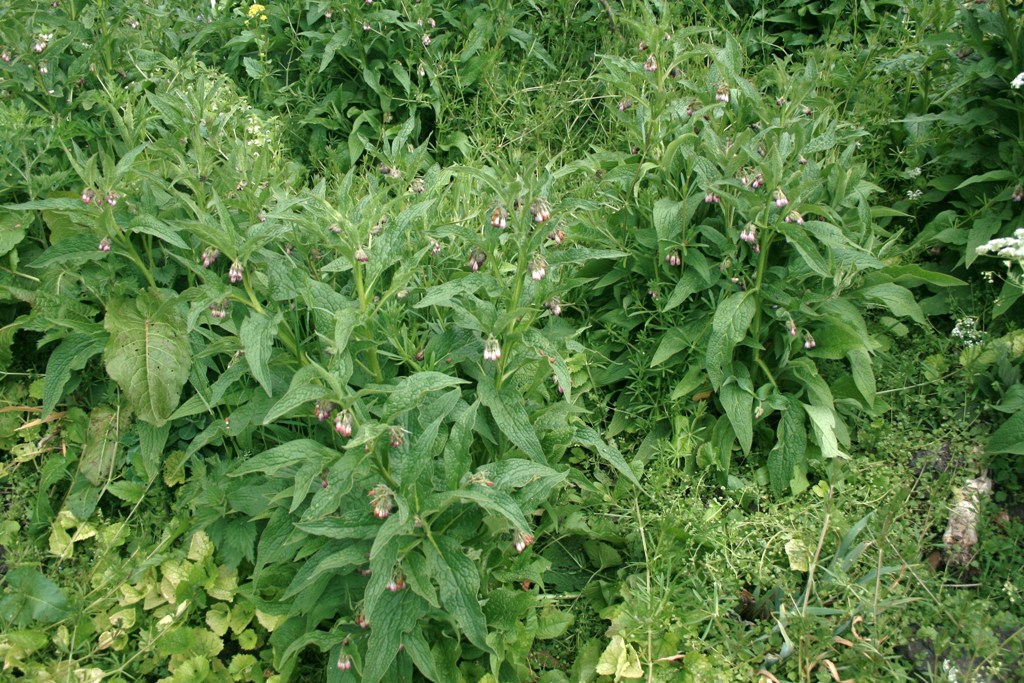
There is so much information concerning the comfrey which is also, like the plants in the blog of last week, in the Boraginaceae Family. This week therefore, my post will concern itself purely with comfrey.
Pictures by Matt Summers, Mike Poulton and contributors from Wikipedia Commons.
Contents:
Symphytum spp. or Comfreys in the B.I.
Symphytum officinale or Common Comfrey
S. × uplandicum or Russian Comfrey (Symphytum asperum × officinale)
Garden Organic and history of Comfrey there
The other species:
Symphytum grandiflorum or Creeping Comfrey
- Symphytum orientale or White Comfrey
- Symphytum tauricum or Crimean Comfrey
- Symphytum tuberosum or Tuberous Comfrey
Symphytum spp. or Comfreys in the B.I.
Stace describes 11 species/hybrids as well as subspecies. The ones listes in the Plant Atlas can be found below.
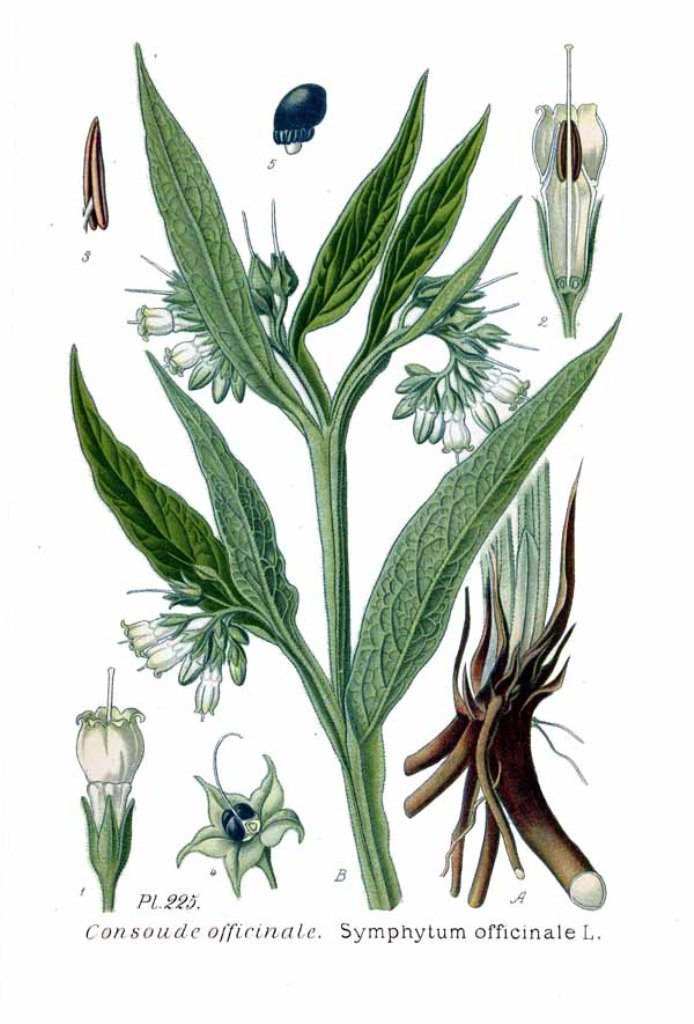
Symphytum officinale or Common Comfrey
A tall perennial herb of riverbanks, streamsides and associated ditches, fens and marshes. It is also an occasional escape from cultivation on waste ground and roadsides. The identification of S. officinale requires not only the long wings on the stem, but also very narrow upper stem leaves with a broad (1–2 cm) leaf decurrence at the stem junction and an absence of blue or violet coloration in the flowers.
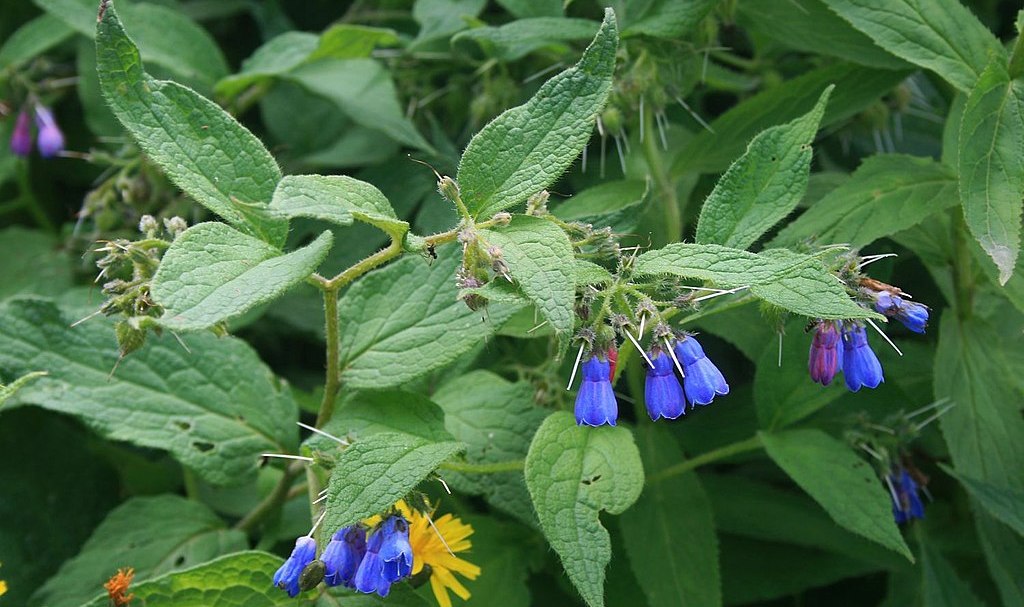
A very tall comfrey, morphologically similar to S. × uplandicum and, like that species, able to compete with tussocky grasses and rank vegetation, but occurring only very occasionally on road verges, tracksides and in churchyards. It produces abundant seedling plants around clonal patches, but, unlike S. × uplandicum, is probably not resistant to frequent mowing.
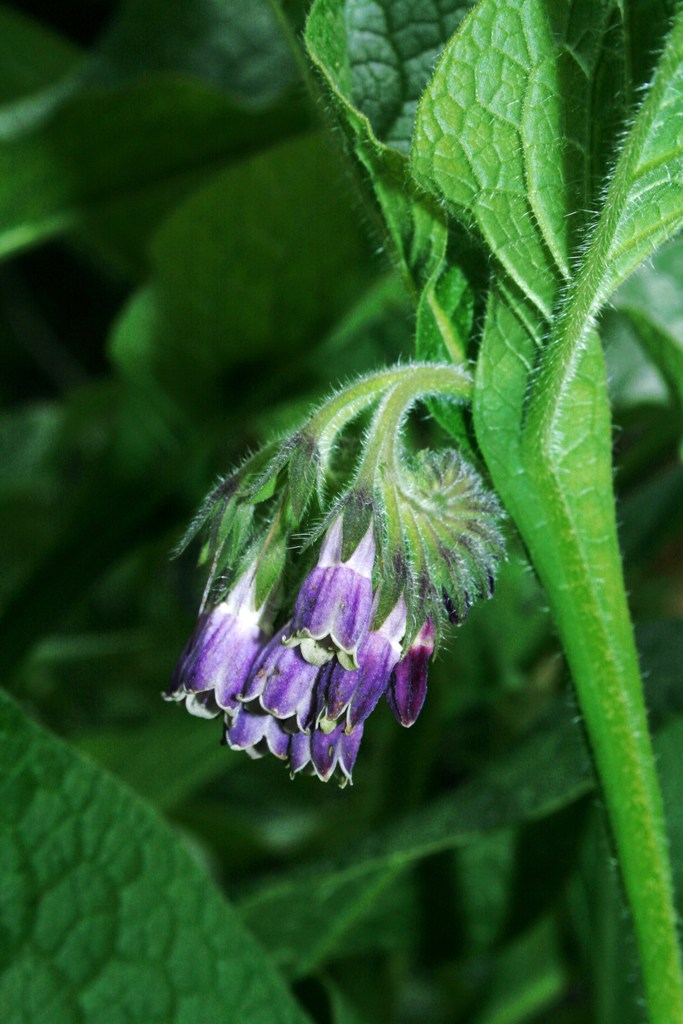
S. × uplandicum (Symphytum asperum × officinale) or Russian Comfrey
A very tall and robust perennial herb of moist, fertile soils, long established on woodland margins, hedgebanks, road verges, tracks, waste ground, railway embankments, stream- and ditch-banks; also a relic of cultivation on allotments and in old gardens. It forms clonal patches competing with tall grass and herbage, seldom with associated seedling plants. It continues to extend its range away from roads along footpaths, tracks and riverside paths. Mainly spread vegetatively by cutting machinery.
Garden Organic and history of Comfrey there:
The ‘Garden Organic’ movement, has had its 60 years anniversary and comfrey is very much part of their history. There was an article on comfrey in the latest edition of their membership magazine and I would like to share some of it with you:
As Kim Stoddart wrote:- “How many gardeners nowadays have comfrey growing somewhere on their plot? I’d wager rather a lot. It’s a very useful plant indeed. Its foliage can be harvested and used either as a compost accelerator or made into the potent natural fertilizer, ‘comfrey tea’, which is especially beneficial for hungry fruits and flowers.”
With the most commonly sold variety, which carries forth the legacy in its name, Bocking 14, we are privileged nowadays to have a strain which boast a much higher nutrient content than the common comfrey growing wild in the UK and which has many more benefits besides.
Comfrey’s place in Garden Organic’s history
“Henry Doubleday, a smallholder and inventor from Essex, originally imported Russian Comfrey from St. Petersburg in the 19th century with the intention of turning it into a glue for stamps. This didn’t prove to be viable. Yet over 60 years later, interest in its medicinal value and use as a high protein fodder crop for livestock intrigued Lawrence Hills. After writing a book entitled ‘Russian Comfrey’ in 1953, Hills went onto set up HDRA, named in honour of Doubleday, and based at Bocking in Essex. He had the intention of researching comfrey’s full potential, as he saw it as a way to ‘feed the world’.
Until the end of the 1972, this plant formed an important focus of the organisation with members looking into the nutritional and health qualities in particular, with a view also to seeing whether it could contribute to food security in the UK and abroad.
It was during the 1980s that work moved away from the medicinal possibilities for comfrey, and focused on its fertility benefits”.
The name is from the Latin confervere, ‘to grow together, to consolidate’ that, via Medieval French, became ‘conforye’ by the 15th century. Symphyo in Greek is to make whole, to heal.
Comfrey is always the herb of choice for both internal and external use when it comes to fractures and sprains. It can also be given after surgical operations, especially those involving bone and cartilage. It is given to help repair wounds and also for the connective tissue disorders including rheumatoid arthritis and the vasculitides and also does well in osteoarthritis.
As an astringent and demulcent, it is invaluable in the treatment of peptic ulcers and also for inflammatory disease of the bowel.
Parts used: Harvesting of leaves can last for a whole season, but avoid first leaves and don’t use after early October. The roots and rhizomes can be used Sept-Oct or in spring
Action: Astringent and Antihaemorrhagic, Vulnerary. Demulcent. Cell proliferant.
Uses: Internally: Gastric and duodenal ulcer. Colitis. Arthritis.
Externally: Varicose and other ulcers, wounds, fractures, sprains, herniae. Athlete’s foot (leaf only, in ointment, to which Oil of Thyme may be added).
There are some ornamental forms for the garden:
Symphytum x uplandicum ‘Variegatum’ &
Symphytum x uplandicum ‘Moorland Heather’
- Comfrey is a source of fertilizer to the organic gardener.
- It is very deep rooted and acts as a dynamic accumulator, mining a host of nutrients from the soil. (In fact there is little scientific evidence that the nutrients in comfrey are more concentrated than in other plants, nor that the nutrients have come from its deep roots rather than, as is the case in most plants, from its near-surface roots. )
- The nutrients that are available in comfrey are made available through its fast-growing leaves which, lacking fibres, quickly break down to a thick black liquid.
- There is also no risk of nitrogen loss when comfrey is dug into the soil as the C:N ratio of the leaves is lower than that of well-rotted compost.
- Comfrey is an excellent source of potassium, an essential plant nutrient needed for flower, seed and fruit production. Its leaves contain 2–3 times more potassium than farmyard manure, mined from deep in the subsoil, tapping into reserves that would not normally be available to plants.
There are various ways in which comfrey can be used as a fertilizer. These include:
- Comfrey as a compost activator – include comfrey in the compost heap to add nitrogen and help to heat the heap. Comfrey should not be added in quantity as it will quickly break down into a dark sludgy liquid that needs to be balanced with more fibrous, carbon-rich material.
- Comfrey as a mulch or side dressing – a two-inch layer of comfrey leaves placed around a crop will slowly break down and release plant nutrients; it is especially useful for crops that need extra potassium, such as fruit bearers but also reported to do well for potatoes. Comfrey can be slightly wilted before application optionally, but either way avoid using flowering stems as these can root.
- Comfrey as a companion plant for trees and other perennials – soil tests confirm that soil nutrients increase in the presence of comfrey even when it is not used as mulch, side dressing, or liquid fertilizer, but just allowed to grow.
- Comfrey potting mixture – originally devised to utilize peat, now environmental awareness has led to a leaf mould-based alternative being adopted instead; two-year-old, well decayed leaf mold should be used, this will absorb the nutrient-rich liquid released by the decaying comfrey. In a black plastic sack alternate 7–10 cm (2.8–3.9 in) layers of leaf mould and chopped comfrey leaves. Add a little dolomitic limestone to slightly raise pH. Leave for between 2–5 months depending on the season, checking that it does not dry out or become too wet. The mixture is ready when the comfrey leaves have rotted and are no longer visible. Use as a general potting compost, although it is too strong for seedlings.
- Finally as comfrey tea which is the liquid collected in a container after breaking down. There are lots of recipes: this is one: It always should be diluted approx 1: 10/15 ratio!! Or see this article by Alys Fowler in the Guardian newspaper here:
Please Note: This plant contains small quantities of a toxic alkaloid which can have a cumulative effect upon the liver. Largest concentrations are found in the roots, leaves contain higher quantities of the alkaloid as they grow older and young leaves contain almost none. Most people would have to consume very large quantities of the plant in order to do any harm, though anyone with liver problems should obviously be more cautious.
In general, the health-promoting properties of the plant probably far outweigh any possible detriments, especially if only the younger leaves are used.
- Young leaves – cooked or raw. The leaf is hairy and the texture is mucilaginous. It may be full of minerals, but it is not pleasant eating for most tastes. It can be chopped up finely and added to salads, in this way the hairiness is not so obvious.
- Young shoots can be used as an asparagus substitute. The blanched stalks are used.
- Older leaves can be dried and used as a tea.
- The peeled roots are cut up and added to soups.
- A tea is made from the dried leaves and roots.
- The roasted roots are used with dandelion and chicory roots for making coffee.
The other species of Comfrey:
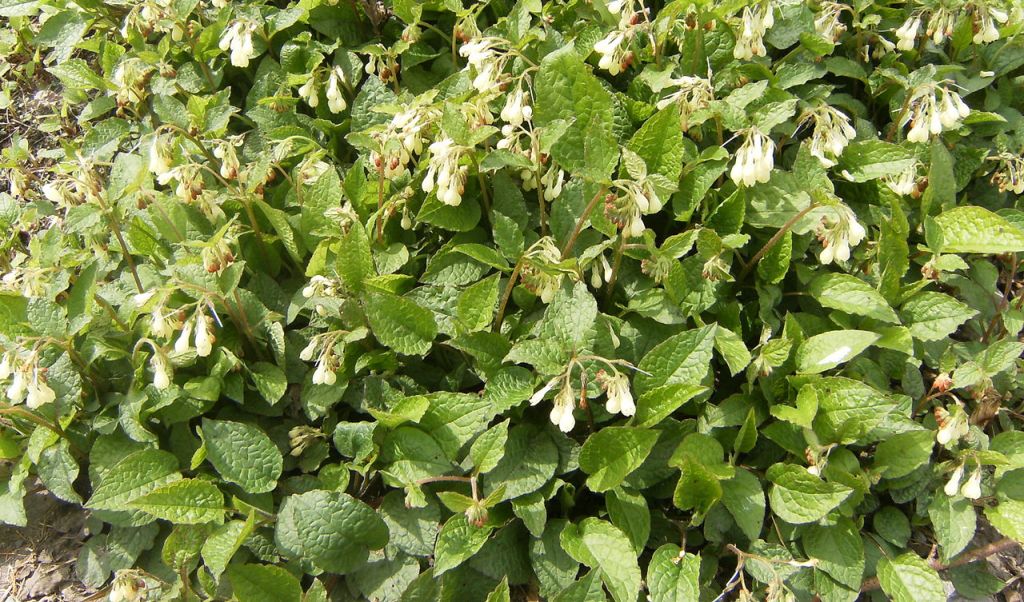
S. grandiflorum or Creeping Comfrey
A perennial herb, spreading vegetatively by rhizomes which produce long, leafy stolons and potentially forming very large clonal colonies. Widely planted as ground cover in gardens and parks and found on roadsides, in hedgerows, woods, and plantations and on streamsides, often where dumped in garden waste although some populations have clearly originated from material washed down streams.
This a much used groundcover plant in gardens with the benefit of early flowers for the bees!
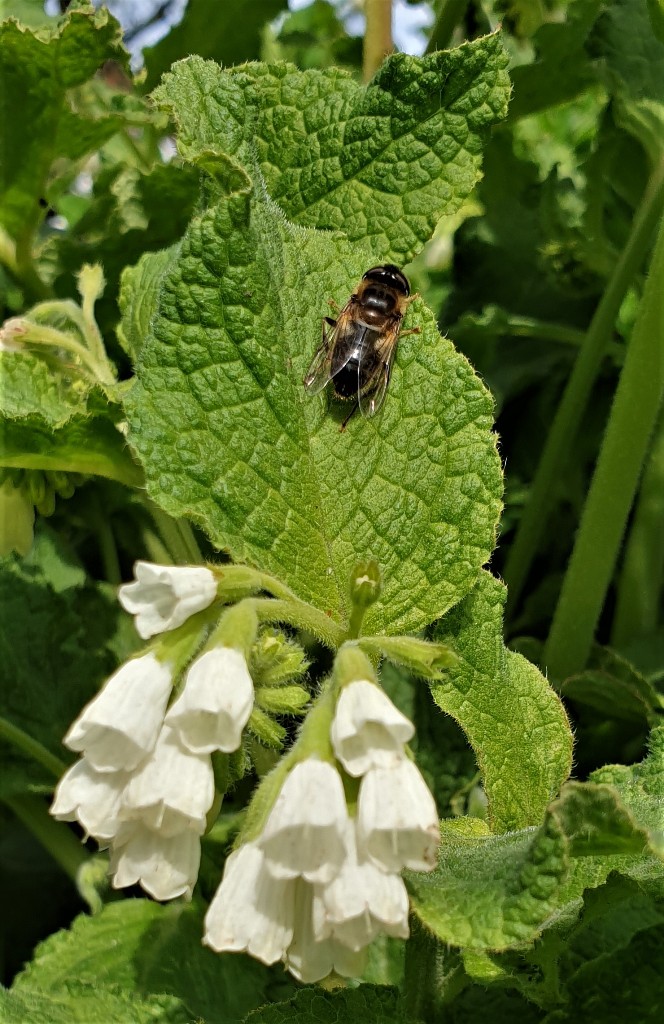
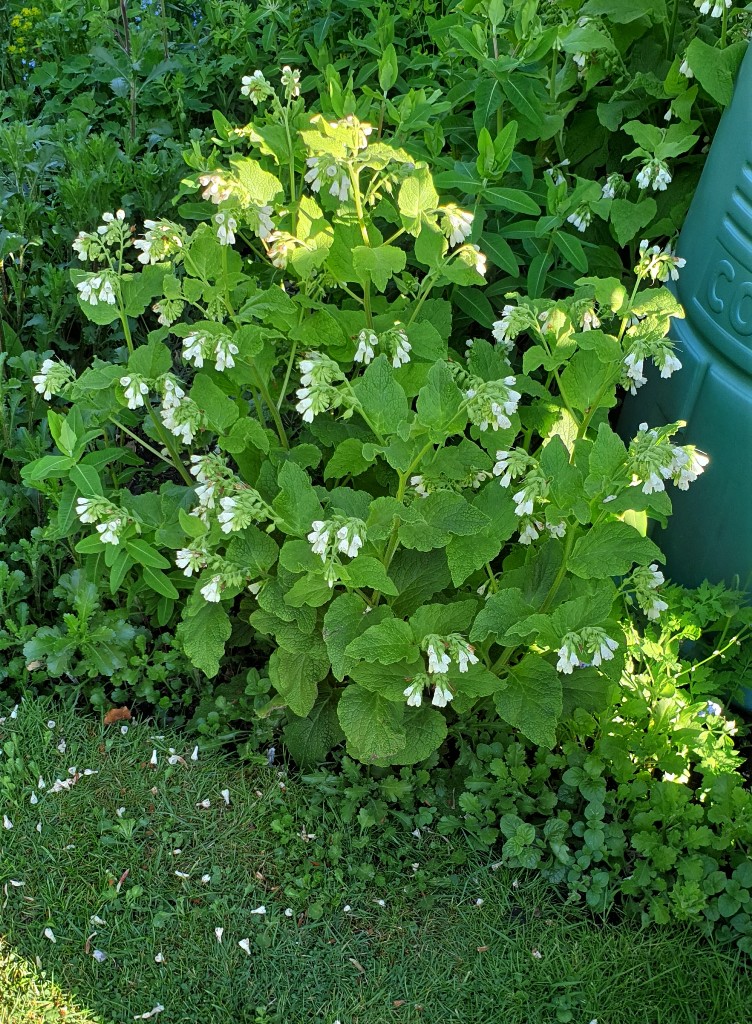
Early flowering White Comfrey or Symphytum orientale (by Mike Poulton)
